5 things you should know about the Hudson Hornet
If you think the replacement of bootleggers by professionals was the big tipping point in stock-car racing history, the latest documentary—embedded at the end of the article—from the Hagerty Drivers Foundation will likely teach you a few things. Today’s NASCAR would not exist if it were not for the drivers and teams who took a humble, straight-six-powered coupe racing in the 1950s. Here are five things you should know about the Hudson Hornet, the car that changed racing history.
The Hornet was never supposed to be a race car
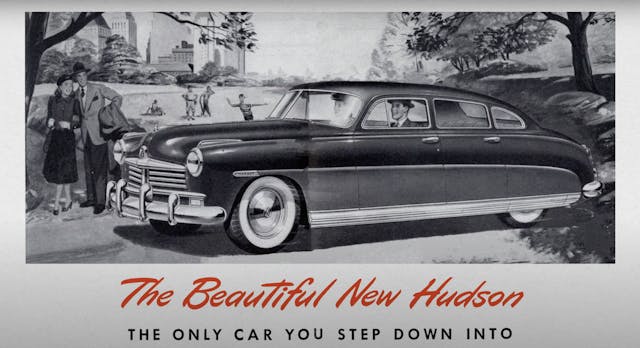
Hudson barely survived WWII. Because its manufacturing power was lower than that of General Motors or Ford, Hudson received fewer contracts, thus entering the 1940s a step or two behind the competition. Hudson was not going to roll over, though. It pushed to create something new and attractive, a vehicle that boasted safety, performance, and comfort. The Commodore was born in 1948 and primed the buying public for the coming Hornet.
It has a uni-body design
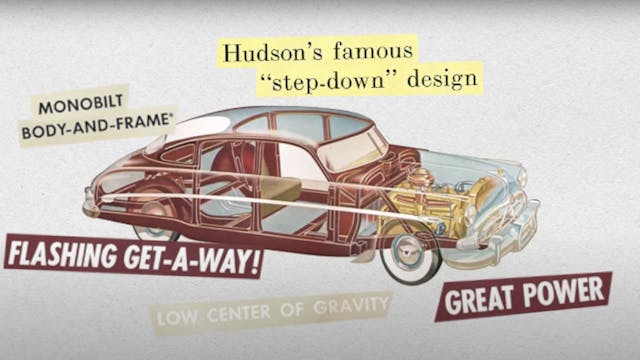
Hudson was not even close to producing the first unibody car, but its design and construction introduced what became the calling card for Hudsons of the era: the “step down.” Since the rocker panel was a structural part of the chassis, it was much more robust than on other cars, requiring engineers to either raise the floor to the height of the sill or lower the floor beneath the sill.
The Hornet was primed to win thanks to Bill France
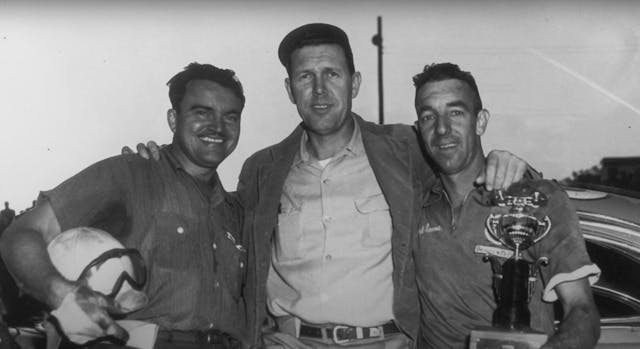
It was not until mid-1949 that driver and race promotor Bill France finally debuted a class called “strictly stock,” which showcased new cars that looked like those that people drove to work. France’s decision fed the idea that anyone could be a racing driver if they had “it” in them. Anyone not aspiring to race could at least cheer for a car that looked like the one in their driveway.
The chassis was good, but the engine was great
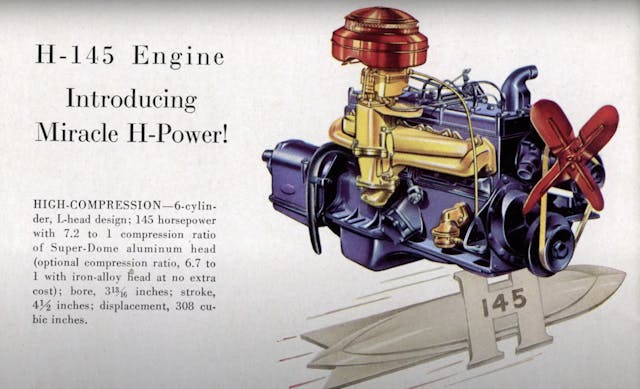
Hudson’s new-for-1951 inline-six displaced 308 cubic inches and was claimed to produce 145 horsepower. Cars in this era were just barely cracking triple-digit speeds—if at all—as pointed out by Richard Petty, who was then running a 97-hp Plymouth. As strange as it is to think of an inline-six as a competition engine, Hudson’s was the hot setup.
The wheels were the weak point
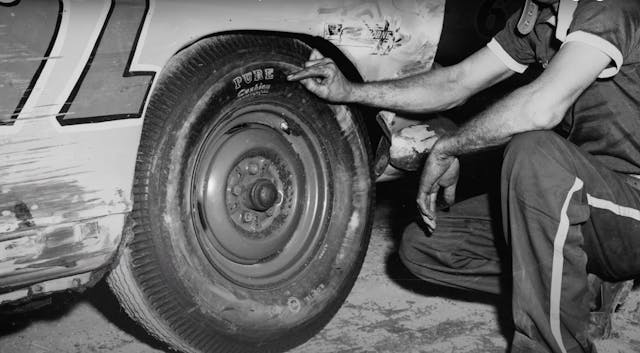
Of all the teething problems that plagued these early stock cars, wheels were one of the most troublesome. The cornering forces generated in racing were so much higher than those produced by regular street driving that the wheels would liberate themselves from their axle or bend to the point of deforming. Hudson solved the problem by reinforcing the steel wheels with what amounted to a second wheel welded onto the first. You could even order the setup on production cars as a “severe duty” option.
***
The Hudson Hornet shaped the sport that would become stock-car racing. Because of its contribution, it will be documented forever in the Library of Congress thanks to the Hagerty Drivers Foundation. Check out the other 33 cars currently on the federally recognized National Historic Vehicle Register as well; there are even more fun stories to be found.
***
Check out the Hagerty Media homepage so you don’t miss a single story, or better yet, bookmark it. To get our best stories delivered right to your inbox, subscribe to our newsletters.
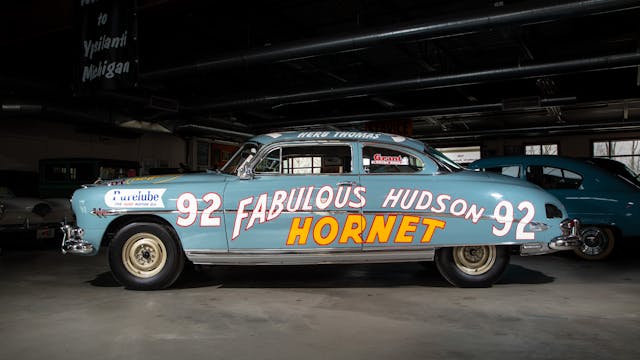


Richard Petty was only 14 years old in 1951 so he was probably not racing with the big boys when the Hudson was winning races.
A great video of a great car being driven by great drivers. Thank you. Back in the late fifties I owned a 1948 Commodore straight 8 convertible painted pale blue. Gee, that car could really pull the chicks. My elder brother also had the same Commodore 8 but his was a sedan. Both had the oil clutch and whereas his had endless trouble mine never gave me a hint of a problem, I think he must have had a heavier foot than me!
Dad had a 52 Wasp. I was involved in changing the clutch release bearing, sitting on the end of a 2 x 4 as counterbalance to the transmission. Smooth Powerful “See ;the USA in a Hudson”.
My parents owned a 1949 Hudson Commodore 8 that they drove to Guadalajara Mexico from New Jersey to visit my Mom’s Uncle and his family. When they got back, My dad traded it in on a 1950 Hudson Commodore 8 since the 49 had so many miles on it! We then moved to California in 1951 With one of my Mom’s brother who also owned a Hudson! Two years later, my Mom’s other brother moved to California in his green Hudson Hornet. That Hornet is now owned by Jay Leno and is now painted Yellow since he already had a green one. They were great cars!
I linked to view the cars listed in The National Historic Vehicle Register and am puzzled by 2 that are missing and the idea to build both of them came from Lee Iacocca. First off, I’m not knocking the inclusion of any of them, but the first built 67 Camaro was listed as being significant in the pony car wars. OK, it was and I’m not knocking its inclusion. But what about the first pony car, the 1964 1/2 Mustang? And why isn’t the 1964 GTO listed? The GTO is credited with starting the muscle car era. Both of these cars should be on the list.
My everlasting memory of a Hudson Hornet comes from Jack Kerouac’s classic novel “On the Road.”
Sal (Jack Kerouac) Paradise riding shotgun to Dean (Neal Cassidy) Moriarity, hunched over the steering wheel of a ‘48 step down Hudson, chain smoking Camels, and into a deep existential rant as they roared down U.S. 6 in Nebraska, in the dead of night doing the ton.
I have been in love with Hudsons ever since.
I am lucky enough to have driven a Hudson on a long distance trip in 2016. It was my best buddies car that he needed to get home….he was driving a 51 convertible, me a 49 four door. He and his Dad have 4 Hudsons. Fantastic cars even by todays standards.
My other Hudson connection was my neighbor back in the 1980’s in Mint Hill NC. Tim Flock and his wife lived a few doors down from me. I did some artwork for them and got them together with Moebius plastic model company to make models of Tim’s cars. Great great people.
As close as I can get to owning a Hudson is my 73 Javelin!!!! Family anyway
I bought I think a 1951 Hudson Hornet in 1960 and drove it from Alabama to Pennsylvania then on to Montana. I was in the Air Force. Montana did not have speed limits on Highway 2 and I drove it all over Montana at 110 mph. Never had a problem and it just hunkered down and flew. It had dual carbs Wish I’d kept it
Turn right to go left!
The Andretti’s first race car was a Hudson
My uncle worked for Hudson as a die maker and drove a succession of Hornets during the early 1950’s. He always amazed my dad as Uncle Edgar would make the trip up to Pentwater from Detroit in a matter hours on two lane highways, no I96. When my dad asked him how he did it, he would say ” Man, that Hudson goes!”
How come nobody ever says anything about the Oldsmobile rocket V8 Oldsmobile started out winning all the NASCAR races and were very competitive against the Hudson hornet. I was to understand the Hudson was a Better Engine as far as staying cool because the Oldsmobile Engine did not have full coolant around the cylinders but it was quite a bit faster. I just don’t get it. They make such a big deal out of a Hudson. They never say anything about the Oldsmobiles. How can you compare an overhead valve? V8 engine to a flathead six. What kind of car won the first Daytona 500 on the racetrack that we have now? It was a 59 Oldsmobile driven by Lee Petty. Look and see how many times, Oldsmobile won the Daytona race on the sand compared to a Hudson.
When I was 17 back in 1970 I saw a bunch of cars in a pasture at an abandoned farm yard. One was a Hornet. I had heard about their stock car legends so I popped the hood and there sat a Cadillac V-8. Surprised the heck out of me. I sure wish I would made an effort to acquire that car.
Perhaps it was a regional thing, but I spent my youth (haven’t grown up yet… (-: ) in Connecticut and my first recollection of the term “Lead Sled” always referred to a chopped and channeled Hudson Hornet in the early 60s. It was much later when ’51 or so Mercury’s kinda took over the title. It seems that now any chopped and channeled sedan from that era is called a Lead Sled.
I just did a Google search for Lead Sleds and found just about every manufacturer EXCEPT Hudson.
Strange…
Hudsons held the record for NASCAR wins (by manufacturer) until the 70s when Petty broke the record with a Plymouth. Hudsons hadn’t raced since 1954, though some may have been allowed in official NASCAR events in 1955. I don’t think any of the Nash body based Hudson raced in NASCAR — they certainly didn’t bring in first place wins. Took 20 years for another manufacturer to exceed the number of wins Hudsons achieved in just five years (maybe six…)!! Handling was the Hudson’s main virtue. The big 308 six was powerful, but Buick, Chrysler and others had more powerful V-8s in the mid 50s. Between handling and better low speed torque the Hudsons ran away from them.